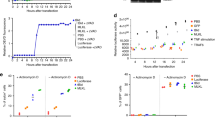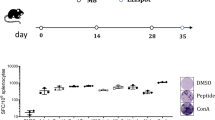Abstract
Purpose
Immunotoxins as anti-cancer therapeutics have several potential advantages over conventional agents including a high specificity, extraordinary potency, and a lack of an identified mechanism for resistance. It has been clearly demonstrated that Pseudomonas-based immunotoxins have a direct cytotoxic effect. However, delayed and often dramatic antitumor responses seen in human studies with targeted toxins led us to hypothesize that immunologic responses may be a secondary mechanism that enhances the therapeutic efficacy of these novel drugs.
Experimental design
This hypothesis was tested in a murine system using an immunotoxin, MR1-1 [MR1-1(dsFv)-PE38KDEL], that targets a syngeneic murine homologue of the tumor-specific human epidermal growth factor mutation, EGFRvIII, expressed on a murine cell line.
Results
Intratumoral treatment with MR1-1 eliminated EGFRvIII-expressing tumors (P < 0.0001). The antitumor activity of MR1-1 was dependent on the expression of EGFRvIII on some, but not all tumors cells, and was significantly inhibited in the absence of CD4+ (P = 0.0193) and CD8+ (P = 0.0193) T cells. MR1-1 induced EGFRvIII-specific immunity (P < 0.0005) and produced long lasting immunity against tumors expressing EGFRvIII as well as EGFRvIII-negative tumors.
Conclusions
These data suggest that immunotoxins may not be strictly dependent on direct cytotoxicity for their efficacy, but may also be potent inducers of antitumor immunity active even against cells that do not express the targeted antigen.





Similar content being viewed by others
Abbreviations
- EGFRvIII:
-
Epidermal growth factor receptor variant III
- Anti-Tac(dsFv)-PE38:
-
Anti-CD25(dsFv)-PE38KDEL immunotoxin
- MR1-1:
-
MR1-1(dsFv)-PE38KDEL immunotoxin
References
Archer GE et al (1999) Regional treatment of epidermal growth factor receptor vIII-expressing neoplastic meningitis with a single-chain immunotoxin, MR-1. Clin Cancer Res 5:2646–2652
Decker T et al (2004) Induction of caspase-dependent programmed cell death in B-cell chronic lymphocytic leukemia by anti-CD22 immunotoxins. Blood 103:2718–2726
FitzGerald DJ et al (2004) Recombinant immunotoxins for treating cancer. Int J Med Microbiol 293:577–582
Groh V et al (2005) Efficient cross-priming of tumor antigen-specific T cells by dendritic cells sensitized with diverse anti-MICA opsonized tumor cells. Proc Natl Acad Sci USA 102:6461–6466
Hall WA, Fodstad O (1992) Immunotoxins and central nervous system neoplasia. J Neurosurg 76:1–12
Heath WR, Carbone FR (2001) Cross-presentation in viral immunity and self-tolerance. Nat Rev Immunol 1:126–134
Kreitman RJ et al (2001) Efficacy of the anti-CD22 recombinant immunotoxin BL22 in chemotherapy-resistant hairy-cell leukemia. N Engl J Med 345:241–247
Kuan CT et al (1999) 125I-labeled anti-epidermal growth factor receptor-vIII single-chain Fv exhibits specific and high-level targeting of glioma xenografts. Clin Cancer Res 5:1539–1549
Kuan CT et al (2000) Increased binding affinity enhances targeting of glioma xenografts by EGFRvIII-specific scFv. Int J Cancer 88:962–969
Kurts C et al (2001) Dendritic cells are sufficient to cross-present self-antigens to CD8 T cells in vivo. J Immunol 166:1439–1442
Lorimer IA et al (1996) Recombinant immunotoxins specific for a mutant epidermal growth factor receptor: targeting with a single chain antibody variable domain isolated by phage display. Proc Natl Acad Sci USA 93:14815–14820
Lorimer IA et al (1995) Immunotoxins that target an oncogenic mutant epidermal growth factor receptor expressed in human tumors. Clin Cancer Res 1:859–864
Matzinger P (2002) The danger model: a renewed sense of self. Science 296:301–305
Melief CJ (2003) Mini-review: regulation of cytotoxic T lymphocyte responses by dendritic cells: peaceful coexistence of cross-priming and direct priming? Eur J Immunol 33:2645–2654
Onda M, Bruland OS, Pastan I (2005) TP-3 immunotoxins improve antitumor activity in mice with osteosarcoma. Clin Orthop 430:142–148
Onda M et al (2003) Mutants of immunotoxin anti-Tac(dsFv)-PE38 with variable number of lysine residues as candidates for site-specific chemical modification. 1. Properties of mutant molecules. Bioconjug Chem 14:480–487
Onda M et al (2004) In vitro and in vivo cytotoxic activities of recombinant immunotoxin 8H9(Fv)-PE38 against breast cancer, osteosarcoma, and neuroblastoma. Cancer Res 64:1419–1424
Parney IF et al (2005) Neuroradiographic changes following convection-enhanced delivery of the recombinant cytotoxin interleukin 13-PE38QQR for recurrent malignant glioma. J Neurosurg 102:267–275
Pastan I (2003) Immunotoxins containing Pseudomonas exotoxin A: a short history. Cancer Immunol Immunother 52:338–341
Pastan I, Beers R, Bera TK (2004) Recombinant immunotoxins in the treatment of cancer. Methods Mol Biol 248:503–518
Pastan I, Kreitman RJ (2002) Immunotoxins in cancer therapy. Curr Opin Investig Drugs 3:1089–1091
Rainov NG, Heidecke V (2004) Long term survival in a patient with recurrent malignant glioma treated with intratumoral infusion of an IL4-targeted toxin (NBI-3001). J Neurooncol 66:197–201
Sampson JH et al (2003) Progress report of a phase I study of the intracerebral microinfusion of a recombinant chimeric protein composed of transforming growth factor (TGF)-alpha and a mutated form of the Pseudomonas exotoxin termed PE-38 (TP-38) for the treatment of malignant brain tumors. J Neurooncol 65:27–35
Sampson JH et al (1996) Subcutaneous vaccination with irradiated, cytokine-producing tumor cells stimulates CD8+ cell-mediated immunity against tumors located in the “immunologically privileged” central nervous system. Proc Natl Acad Sci USA 93:10399–10404
Sampson JH et al (1997) Characterization of a spontaneous murine astrocytoma and abrogation of its tumorigenicity by cytokine secretion. Neurosurgery 41:1365–1372 (discussion 1372–1373)
Sampson JH et al (2000) Unarmed, tumor-specific monoclonal antibody effectively treats brain tumors. Proc Natl Acad Sci USA 97:7503–7508
Sampson JH et al (2005) Sustained radiographic and clinical response in patient with bifrontal recurrent glioblastoma multiforme with intracerebral infusion of the recombinant targeted toxin TP-38: case study. Neuro Oncol 7:90–96
Thomas SM et al (2004) Abrogation of head and neck squamous cell carcinoma growth by epidermal growth factor receptor ligand fused to Pseudomonas exotoxin transforming growth factor alpha-PE38. Clin Cancer Res 10:7079–7087
Acknowledgments
The work was supported by the following grants: 1P50 CA108786-01 (D. D. Bigner/J. H. Sampson), 2P50-NS20023-21 (D. D. Bigner/J. H. Sampson), 1R01 CA097222 (J. H. Sampson), 1R01 CA097611 (J. H. Sampson), K23 RR16065 (J. H. Sampson) along with support from the ABC2 Foundation (D. D. Bigner/J. H. Sampson) and the Sidney Kimmel Foundation for Cancer Research (Sampson). This research was supported in part by the Intramural Research Program of the NIH, National Cancer Institute, Center for Cancer Research (I. H. Pastan). We acknowledge the technical assistance of Tracy Chewning and editorial assistance of Shenell Summers.
Author information
Authors and Affiliations
Corresponding author
Rights and permissions
About this article
Cite this article
Ochiai, H., Archer, G.E., Herndon, J.E. et al. EGFRvIII-targeted immunotoxin induces antitumor immunity that is inhibited in the absence of CD4+ and CD8+ T cells. Cancer Immunol Immunother 57, 115–121 (2008). https://doi.org/10.1007/s00262-007-0363-7
Received:
Accepted:
Published:
Issue Date:
DOI: https://doi.org/10.1007/s00262-007-0363-7




